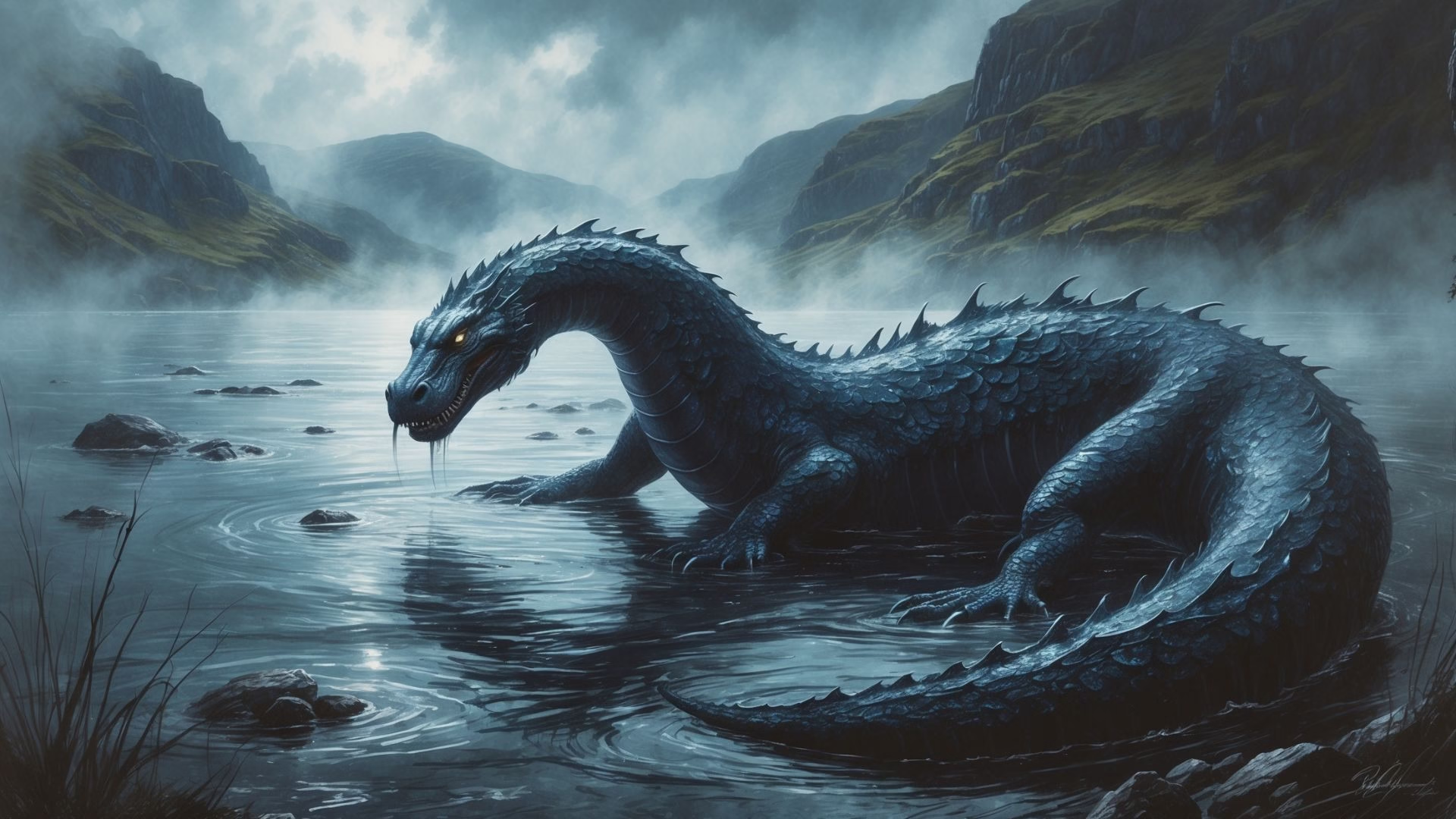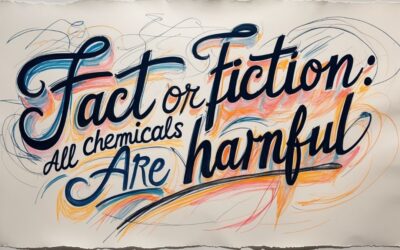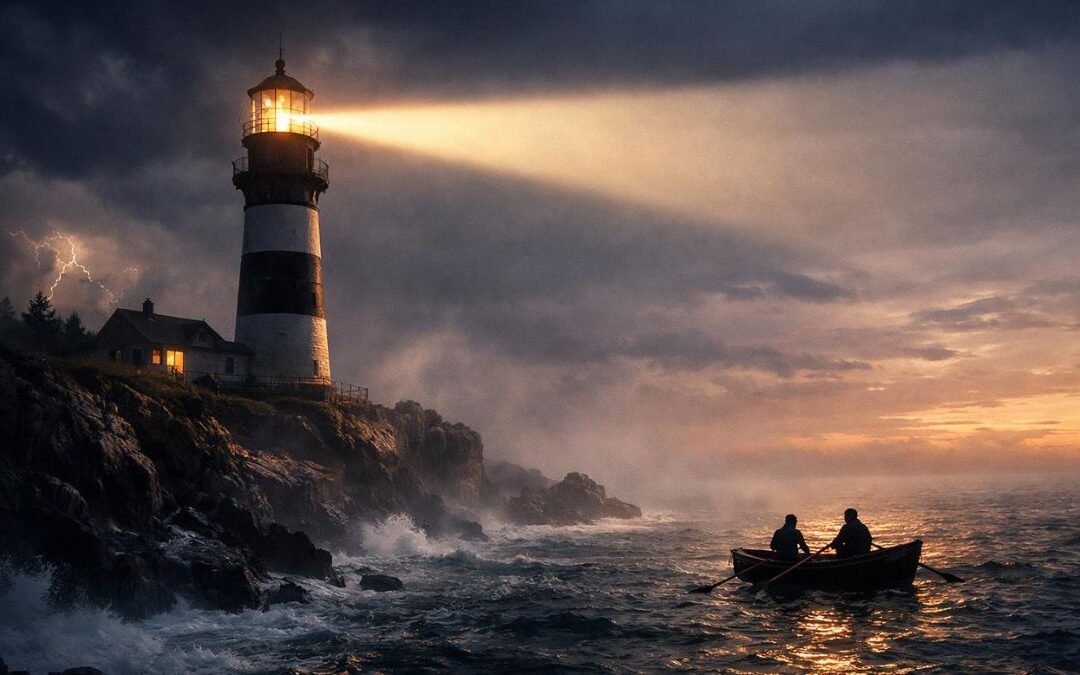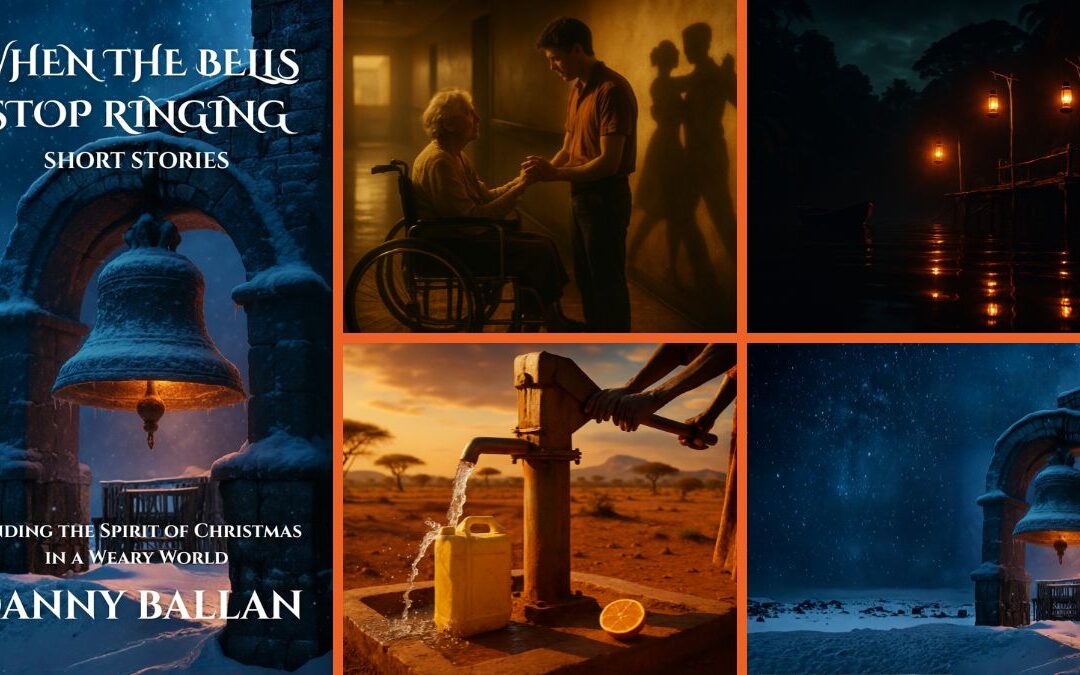- The Deep Dive
- The Allure of the Deep: An Introduction to Mystery
- Ripples Through Time: The Genesis of a Legend
- The “Smoking Gun” Photos and Films: Proof or Provocation?
- Science Wades In: Sonar, DNA, and Biological Plausibility
- The Power of Perception: Psychology and Pareidolia
- Nessienomics: The Monster That Minted Millions
- The Verdict: A Legend Lives On, But Does the Creature?
- Reading Comprehension Quiz
- Let’s Talk | Listening Practice
- Listening Comprehension Quiz
- Let’s Learn Vocabulary in Context
- Vocabulary Quiz
- Let’s Discuss & Write
- Learn with AI
- Let’s Play & Learn
The Deep Dive
The Allure of the Deep: An Introduction to Mystery
Scotland. A land of mist-shrouded mountains, ancient castles, and kilts flapping defiantly in the Highland breeze. But nestled within its dramatic landscape lies a body of water arguably more famous than any other: Loch Ness. Deep, dark, and extraordinarily long, this freshwater loch holds more water than all the lakes in England and Wales combined. Yet, it’s not the sheer volume of water that captures the global imagination; it’s the tantalizing possibility of what might be swimming within its peat-stained depths. We’re talking, of course, about Nessie, the Loch Ness Monster – arguably the world’s most famous cryptid. But after centuries of whispers, decades of searches, and countless blurry photographs, the question remains stark: Is Nessie a genuine biological marvel, a relic of a bygone era, or simply a magnificent myth, perpetuated by hope, hoax, and happenstance? Let’s plunge into the evidence, or lack thereof, and try to surface with some clarity.
Ripples Through Time: The Genesis of a Legend
While the modern frenzy surrounding Nessie kicked off in the 1930s, whispers of strange creatures in the River Ness and the Loch itself date back much further. The earliest recorded tale often cited involves the Irish monk Saint Columba, who, around 565 AD, allegedly encountered a “water beast” threatening a man in the River Ness. According to the account, Columba made the sign of the cross and commanded the beast to retreat, which it promptly did. Skeptics, however, point out that this story was written a century after Columba’s death by his biographer, Adomnán, and fits a common hagiographic trope of saints triumphing over threatening nature or pagan symbols. Furthermore, the account mentions the River Ness, not the Loch itself, and could easily have described an encounter with a known, albeit aggressive, animal.
Fast forward over a millennium. The real catalyst for Nessie-mania was a fateful day in May 1933. A local couple, George Spicer and his wife, reported seeing an “extraordinary form of animal” with a long neck crossing the road near the loch before disappearing into the water. Their account, published in the Inverness Courier, ignited public fascination. The editor, Evan Barron, presciently suggested the term “monster,” and it stuck. Later that year, Arthur Grant claimed he nearly hit a similar creature on his motorcycle, describing it as having a small head, long neck, and flippers – resembling a plesiosaur, an extinct marine reptile. This description heavily influenced popular perception, despite the biological hurdles such a creature would face.
The “Smoking Gun” Photos and Films: Proof or Provocation?
The 1930s frenzy produced the most iconic, and subsequently most controversial, piece of “evidence”: the “Surgeon’s Photograph.” Published in the Daily Mail in 1934 and attributed to Colonel Robert Kenneth Wilson, a London gynecologist, the black-and-white image depicted a long neck and head rising gracefully from the water. For decades, this photograph was hailed as the most compelling proof of Nessie’s existence. It was elegant, mysterious, and seemed undeniably biological.
However, the truth surfaced dramatically in the 1990s. It was revealed that the photo was an elaborate hoax orchestrated by Marmaduke Wetherell, a big-game hunter hired by the Daily Mail to find the monster. After finding suspicious footprints (which turned out to be made with a hippo-foot umbrella stand), Wetherell felt ridiculed and sought revenge. He, along with his son Ian and stepson Christian Spurling, fashioned a “monster” head and neck out of wood putty attached to a toy submarine. They photographed their creation in the loch and used Wilson, a respectable figure, as a credible front man to pass the photo to the press. Spurling confessed on his deathbed, effectively demolishing Nessie’s most famous portrait.
Other visual “evidence” has emerged over the years, including the Dinsdale Film (1960), showing a hump moving through the water, and various sonar contacts picked up during expeditions. Tim Dinsdale’s footage was analyzed by the RAF’s photographic unit, who concluded it likely showed an animate object, though its identity remained elusive. Sonar readings, particularly during “Operation Deepscan” in 1987, detected large, moving underwater objects that couldn’t be immediately identified. However, sonar is notoriously tricky in Loch Ness due to its depth, sloping sides, and potential for thermoclines (layers of water at different temperatures) which can create false echoes. None of these have provided definitive, irrefutable proof.
Science Wades In: Sonar, DNA, and Biological Plausibility
If eyewitness accounts are subjective and photographs can be faked, what does rigorous scientific investigation tell us? Numerous expeditions have swept the loch with sonar, hoping for a clear, undeniable contact. While intriguing blips have appeared, none have resolved into a consistent image of a large, unknown animal. Operation Deepscan, deploying a fleet of boats with sonar, yielded some suggestive readings, but follow-up scans often found nothing, or results could be attributed to known phenomena like seals, logs, or even unusual wave patterns.
More recently, cutting-edge science entered the fray. In 2018, Professor Neil Gemmell from the University of Otago, New Zealand, led a project to catalogue life in Loch Ness by sampling environmental DNA (eDNA). This involves collecting genetic material shed by organisms into their environment (skin cells, scales, feces, urine). By analyzing the DNA sequences found in water samples from across the loch, scientists could identify the species present.
The results, released in 2019, were fascinating, though perhaps disappointing for believers. They found no evidence of DNA from large reptiles like plesiosaurs, nor from large fish like sharks, sturgeon, or catfish. What they did find was a significant amount of eel DNA. Professor Gemmell suggested that the sheer quantity of eel DNA meant it was plausible that some sightings of Nessie could be attributed to unusually large European eels, which can potentially grow much larger than average, perhaps reaching several meters in length. While not confirming giant eels exist there, it offered a scientifically grounded, biological explanation for some sightings that doesn’t require invoking prehistoric survivors.
Furthermore, the plesiosaur hypothesis, popularized by early descriptions and the Surgeon’s Photo, faces significant biological challenges. Plesiosaurs were air-breathing marine reptiles that went extinct around 66 million years ago. For a breeding population to survive undetected in Loch Ness for millennia, they would need to surface frequently for air (leading to more sightings), find sufficient food in a relatively nutrient-poor freshwater loch, and somehow maintain genetic diversity from what must have been a tiny founding population. It stretches biological credibility to breaking point.
The Power of Perception: Psychology and Pareidolia
Why does the legend persist so strongly despite the lack of concrete evidence? Human psychology plays a significant role. Our brains are wired to find patterns, even in random stimuli – a phenomenon called pareidolia. Seeing a monster in a blurry photo, an unusual wave pattern, or a floating log is a classic example. Combine this with confirmation bias – the tendency to favor information confirming existing beliefs – and it’s easy to see how ambiguous sightings get interpreted as “Nessie.”
There’s also the undeniable romance of the unknown. In a world increasingly mapped, measured, and explained, mysteries like Loch Ness offer a sense of wonder and the possibility that not everything is understood. The monster represents the wild, the untamed, the potentially undiscovered corners of our planet. Believing in Nessie, even just a little, is arguably more fun than accepting the mundane reality of eels and echoes.
Nessienomics: The Monster That Minted Millions
It’s impossible to discuss Nessie without acknowledging the colossal tourism industry built around her. The area surrounding Loch Ness thrives on monster-hunters and curious visitors. Hotels, boat tours, souvenir shops, and visitor centers all depend heavily on the enduring legend. This economic reality creates a powerful incentive to keep the mystery alive. While not suggesting a deliberate conspiracy, the financial benefits undoubtedly color local perspectives and encourage the perpetuation of the Nessie narrative. Every blurry photo, every intriguing sonar blip, fuels the engine of tourism.
The Verdict: A Legend Lives On, But Does the Creature?
So, does the Loch Ness Monster exist? Based on the available scientific evidence, the answer is almost certainly no. There is no fossil evidence, no carcasses washed ashore, no definitive DNA proof, and the most compelling photographic “evidence” has been exposed as a hoax. Sightings can largely be explained by misidentification of known animals (eels, seals, otters, swimming deer), inanimate objects (logs, debris), natural phenomena (wind slicks, waves, mirages), and the psychological factors of pareidolia and expectation.
Yet, the legend of Nessie is undeniably real and profoundly powerful. It speaks to our fascination with mystery, our connection to the natural world, and perhaps our yearning for something more than the everyday. Loch Ness itself remains a place of stunning beauty and genuine enigma due to its vastness and depth. While science may have drained much of the water from the monster hypothesis, the allure of the deep, dark loch and the shadow of the creature said to inhabit it will likely continue to ripple through our collective imagination for generations to come. Nessie, the physical creature, may be fiction, but Nessie, the idea, is a fact of cultural history, as enduring as the Scottish Highlands themselves.
Reading Comprehension Quiz
Let’s Talk | Listening Practice
Listening Transcript: Please don’t read the transcript before you listen and take the quiz.
Alright, so we’ve waded through the history, the photos, the science – the whole Nessie shebang. And look, the scientific verdict seems pretty clear, doesn’t it? No plesiosaurs vacationing in Scotland, no secret population of giant unknown leviathans. The evidence just isn’t there. The famous photo? Faked. The DNA? Mostly eels, bless their slippery hearts.
But… isn’t there still a little part of you that wants to believe? Just a tiny bit? I know there is for me. It’s that little flicker of ‘what if?’ that keeps these legends alive. Think about it – why are we so obsessed with monsters? Nessie, Bigfoot, the Yeti… nearly every culture has its legendary creatures lurking just beyond the firelight, just beneath the waves, just out of focus in that grainy photograph. What does that say about us?
Maybe it’s about confronting our fears. These creatures often represent the wild, untamed aspects of nature, the parts we haven’t paved over or fully understood. Or maybe it’s the opposite – maybe it’s about hope. The hope that there’s still magic left in the world, still discoveries to be made that could rewrite the textbooks. Imagine if they did find something definitively Nessie-like tomorrow. Forget eels, I mean something truly other. How incredible would that be? It would change our understanding of biology, of survival, of history.
Of course, the rational part of my brain kicks in pretty quickly. Okay, Danny, let’s be real. The chances are vanishingly small. And this brings up something crucial we navigate every single day: how do we evaluate evidence? It’s not just about lake monsters; it’s about everything. You see a wild claim on social media, a conspiracy theory video, even just an advert making bold promises. How do you decide what’s credible?
The Nessie story is actually a fantastic case study in critical thinking. You have eyewitness accounts – powerful, often sincere, but notoriously unreliable. Memory plays tricks, perception is subjective. Then you have photographic “evidence” – easily faked, even back in the 30s, let alone now with digital manipulation. Then there’s circumstantial evidence, like sonar blips – intriguing, but open to interpretation and often explainable by mundane causes. Finally, you have rigorous scientific investigation, like the eDNA study, which provides testable, verifiable data, even if the results aren’t as exciting as finding a dinosaur.
So, when you encounter information, especially extraordinary claims, maybe run it through a Nessie filter. Is this just an anecdote? Is there photographic proof, and could it be faked? Is there physical, testable evidence? Are there more plausible, less extraordinary explanations? It’s about being skeptical, but not automatically dismissive. It’s about asking questions.
I remember visiting Loch Ness years ago. It’s… immense. Seriously, standing on the shore, looking out over that vast, dark water, you get a feeling. The wind whips down from the hills, the water is choppy and mysterious, and yeah, your imagination starts working overtime. You scan the surface, hoping for that ripple, that shadow. Did I see Nessie? Nah. Saw some lovely ducks, maybe a suspicious-looking log. But the possibility felt potent, hanging in the air like the Scottish mist. That feeling, that atmosphere, is part of why the legend endures. It’s a place that feels like it should have a monster.
And let’s not forget the sheer fun of it all! The tourism, the cheesy souvenirs, the collective storytelling. It’s become part of Scotland’s identity in a weird way. Does anyone really get hurt by people hoping to glimpse a monster? Probably not, as long as we keep our critical thinking caps on when it comes to separating fun folklore from factual claims.
But what about the eels? The eDNA results pointing to potentially very large eels is fascinating in its own right. Could a six-foot, maybe even ten-foot eel, glimpsed briefly in murky water, account for some of the sightings? A thick, dark body moving sinuously? It’s certainly more plausible than a plesiosaur. It doesn’t explain the long-neck reports, of course, but maybe those are the misidentified logs, or the birds, or the outright hoaxes. Perhaps the “Nessie phenomenon” isn’t one thing, but a combination of many different things, all funnelled into one compelling narrative.
It also makes you wonder about the ethics of the hunt. If there was a unique creature in there, should we be chasing it with sonar beams and submarines? Or should we leave it in peace? It’s a hypothetical question, given the evidence, but relevant to how we interact with the natural world and undiscovered possibilities.
Ultimately, the Loch Ness Monster might tell us more about ourselves than about Scottish aquatic life. It reflects our capacity for wonder, our relationship with the unknown, our tendency towards pattern-seeking, and our ability to build entire industries around a good story. It’s a reminder to question what we see and hear, to seek out robust evidence, but also, maybe, to keep a little space open for mystery. Because even if Nessie is just a story, isn’t it a cracking good one? What do you think? If definitive proof emerged tomorrow that Nessie wasn’t real, would you feel a little bit disappointed?
Listening Comprehension Quiz
Let’s Learn Vocabulary in Context
So, we’ve been talking quite a bit about Nessie and the whole mystery surrounding Loch Ness. As we explored the fact versus fiction, we used some pretty useful words and phrases. Let’s zoom in on a few of them, see how they were used, and figure out how you can sprinkle them into your own conversations to sound extra sharp.
First up, we talked about Nessie being perhaps the world’s most famous cryptid. What’s a cryptid? It sounds fancy, but it just refers to any animal or creature whose existence is suggested but hasn’t been scientifically proven. Think Bigfoot, the Yeti, the Chupacabra, and of course, our friend Nessie. So, if your cousin swears he saw a strange winged creature in the woods last night, you could say, “Wow, sounds like you might have encountered a local cryptid!” It’s a great word for those mysterious, unverified critters.
In the article, Nessie was described as elusive. Something that is elusive is difficult to find, catch, or achieve. Nessie is the ultimate elusive creature because, despite decades of searching, nobody has managed to definitively find or capture her. You can use this beyond monsters, though. Maybe you’re trying to understand a complex concept in physics – you could say, “The solution to this equation remains elusive.” Or perhaps you’re trying to get tickets to that super popular concert: “Tickets were incredibly elusive; they sold out in seconds!”
We mentioned the “Surgeon’s Photograph” and how, for a long time, it was seen as compelling evidence. Compelling means evoking interest, attention, or admiration in a powerfully irresistible way. It can also mean ‘not able to be refuted; inspiring conviction’. So, the photo was compelling because it grabbed people’s attention and, for many, seemed like undeniable proof. You might read a book with a compelling storyline that you can’t put down, or hear a speaker make a compelling argument that really makes you think. If someone presents a case with strong evidence and clear logic, you’d call their argument compelling.
However, we learned that the Surgeon’s Photo was eventually debunked. To debunk something means to expose the falseness or hollowness of a myth, idea, or belief. The story of the toy submarine and the staged photo completely debunked the Surgeon’s image as proof of Nessie. Scientists often work to debunk pseudoscientific claims, like miracle cures or perpetual motion machines. If a popular health myth turns out to be untrue, a news article might run with the headline: “Study Debunks Myth About…” It’s all about exposing something as false.
Professor Gemmell’s eDNA study suggested it was plausible that large eels could explain some sightings. Plausible means seeming reasonable or probable. It doesn’t mean it’s definitely true, but it’s believable, it could happen within the realms of known science or logic. So, the giant eel theory is plausible because we know eels live in the loch and unusual size variations can occur in nature. If a friend tells you they were late because of unexpected traffic, that’s usually a plausible excuse. If they say they were late because they were abducted by aliens… maybe less plausible for most of us!
Scientific investigations involve rigorous scrutiny. Scrutiny is critical observation or examination. When scientists analyzed the Dinsdale film or the sonar readings, they subjected them to close scrutiny, looking at every detail to understand what they were seeing. Your research paper might undergo scrutiny by your professor, or a company’s finances might face scrutiny from auditors. It implies a careful, detailed, and often critical look.
Sometimes, evidence is ambiguous. Ambiguous means open to more than one interpretation; having a double meaning, or unclear/inexact. Sonar blips in Loch Ness were often ambiguous – they could have been Nessie, but they could also have been a school of fish, a log, or a technical glitch. An ambiguous statement might leave you wondering what the speaker really meant. If someone gives you ambiguous instructions, you might not know exactly what to do. “Meet me later” is ambiguous; “Meet me at 6 PM outside the cinema” is not.
The belief in Nessie is deeply ingrained in popular culture. Ingrained means firmly fixed or established; difficult to change. It suggests something has become a fundamental part of something else. The legend is so old and so famous that it’s ingrained in the identity of the Loch Ness area and in our collective consciousness about mysteries. You might have ingrained habits that are hard to break, or certain beliefs might be deeply ingrained from your upbringing.
The tourism industry has an interest in perpetuating the myth. To perpetuate means to make something, typically an undesirable situation or an unfounded belief, continue indefinitely. By promoting the mystery, the local businesses help perpetuate the legend of Nessie, ensuring tourists keep coming. Spreading misinformation can perpetuate harmful stereotypes. Continuing cycles of poverty can perpetuate inequality. It’s about keeping something going, often something negative or based on falsehoods.
Finally, the article stressed the lack of tangible evidence. Tangible means perceptible by touch; clear and definite; real. Scientists want tangible proof – like a bone, a tooth, a clear tissue sample, or a high-resolution, verifiable photograph or video. Eyewitness accounts and blurry photos aren’t considered tangible evidence in a scientific context. When discussing business assets, tangible assets include things like buildings, machinery, and inventory – things you can physically touch. An idea or a feeling is intangible, while a contract or a product is tangible.
So there you have it – cryptid, elusive, compelling, debunked, plausible, scrutiny, ambiguous, ingrained, perpetuate, and tangible. Try weaving these into your conversations. Describing that hard-to-get appointment as elusive, calling a convincing movie plot compelling, or recognizing when an explanation is plausible but not proven – it all adds a bit more precision and flair to your English!
Vocabulary Quiz
Let’s Discuss & Write
Let’s Discuss
Here are a few questions to get you thinking and talking about the Loch Ness Monster and the ideas we explored. Share your thoughts!
- Beyond Nessie, what other famous myths or legends fascinate you, and why do you think they hold such power?
- When presented with conflicting information (like eyewitness accounts vs. scientific data), how do you typically decide what to believe? What factors are most important to you?
- Do you think the tourism surrounding Loch Ness helps or hurts the search for truth about what might be in the loch? In what ways?
- If definitive proof emerged tomorrow confirming a large, unknown creature does live in Loch Ness, what do you think the global reaction would be? What should be the next steps?
- How can we encourage healthy skepticism and critical thinking about extraordinary claims without completely dismissing the possibility of genuine mystery or undiscovered phenomena? Where is the right balance?
Let’s Write
Writing Prompt:
Many places around the world have local legends similar to Nessie – mysterious creatures, haunted locations, or unexplained phenomena. Think about a local legend from your own region or one you find particularly interesting. Write a short essay (around 300-400 words) exploring this legend.
Directions & Tips:
- Introduce the Legend: Briefly explain the legend – what is it about? Where does it supposedly take place? What are the key elements of the story?
- Sample phrase: “Nestled in the [Region Name] region, the legend of [Legend Name] tells of…”
- Sample phrase: “For generations, locals have whispered tales about…”
- Explore the “Evidence” (or lack thereof): Discuss any supposed sightings, stories, or physical signs associated with the legend. Are these considered credible? Are there known hoaxes or common explanations?
- Sample phrase: “Supposed evidence often comes in the form of…”
- Sample phrase: “However, skeptics point to… as a more plausible explanation.”
- Analyze its Significance: Why do you think this legend persists? What does it reflect about the local culture, history, or landscape? Does it serve a purpose (e.g., tourism, cautionary tale, sense of identity)?
- Sample phrase: “The endurance of this story seems rooted in…”
- Sample phrase: “Much like the Nessie phenomenon, this legend might tell us more about…”
- Offer Your Perspective: Conclude with your own brief thoughts. Do you find the legend compelling? Do you think there’s any truth to it, or is it purely folklore?
- Sample phrase: “While concrete proof remains elusive, the legend continues to…”
- Sample phrase: “Ultimately, whether fact or fiction, the tale of [Legend Name] serves as a fascinating glimpse into…”
Remember: Use descriptive language to bring the legend to life, but maintain a thoughtful and analytical tone when discussing evidence and significance. Try to incorporate some of the vocabulary we discussed if relevant (like elusive, plausible, ingrained, perpetuate, tangible).
Learn with AI
Disclaimer:
Because we believe in the importance of using AI and all other technological advances in our learning journey, we have decided to add a section called Learn with AI to add yet another perspective to our learning and see if we can learn a thing or two from AI. We mainly use Open AI, but sometimes we try other models as well. We asked AI to read what we said so far about this topic and tell us, as an expert, about other things or perspectives we might have missed and this is what we got in response.
It’s great to delve a bit deeper into this captivating topic. While the main article and Danny’s reflection covered a lot of ground regarding the evidence, hoaxes, and psychology surrounding Nessie, there are a few additional layers and nuances worth considering from a slightly more analytical perspective.
Firstly, let’s touch upon the geological context of Loch Ness itself. It’s a very deep, cold, and murky body of water, carved out by glaciers during the last Ice Age. Its sheer size and depth (over 750 feet at its deepest) naturally lend themselves to mystery. Importantly, it’s part of the Great Glen, a major geological fault line. While not volcanically active, understanding its formation helps appreciate its unique environment. The peat washed down from surrounding hillsides severely limits visibility underwater, making visual confirmation of anything difficult, let alone an elusive creature. This murkiness is key – it allows ambiguity to thrive.
Secondly, while we talked about eels and misidentified known animals, it’s worth briefly expanding on specific natural phenomena often mistaken for ‘monsters’ on large bodies of water. Wind slicks, where a localized calm patch is surrounded by rippled water, can look remarkably like a dark shape on the surface. Boat wakes, long after a vessel has passed, can interact strangely, creating humps and disturbances. Even unusual wave formations, known as seiches (standing waves in an enclosed body of water), can cause unexpected surface movements. And don’t underestimate flocks of birds flying low or swimming together – from a distance, they can create very deceptive shapes. Recognizing the variety of these natural occurrences provides a strong counterpoint to purely anecdotal sightings.
Thirdly, the motivation behind hoaxes like the Surgeon’s Photograph is interesting. It wasn’t just about creating ‘proof’; Marmaduke Wetherell’s hoax was born out of revenge and embarrassment after his initial ‘evidence’ (the hippo-foot prints) was publicly ridiculed. This highlights how personal pride, ego, and the desire for fame or notoriety can fuel deception in the realm of cryptids and the paranormal. It adds a layer of human drama to the story.
Furthermore, from a sociological viewpoint, legends like Nessie often function as powerful forms of place-making and identity. For the communities around Loch Ness, Nessie isn’t just a potential creature; she’s a symbol, a mascot, a shared story that binds the community and gives the region a unique global identity. This cultural embedding makes the legend resilient, regardless of scientific findings. It fulfills a social need for narrative and distinctiveness.
Finally, consider the impact of modern technology. We live in an age where high-resolution cameras are ubiquitous (smartphones!), drones can survey large areas, and portable sonar is more accessible. Yet, despite this technological saturation, clear, verifiable evidence of Nessie hasn’t emerged. If anything, the quality of evidence seems to have decreased since the heyday of grainy photos and film. This lack of modern evidence, in an era of constant surveillance and documentation, is quite telling and strengthens the skeptical viewpoint.
So, while the core arguments remain – lack of tangible proof, plausible alternative explanations, psychological factors – considering the loch’s geology, specific natural mimics, hoax motivations, sociological functions, and the implications of modern technology adds further depth to our understanding of why the Loch Ness Monster is such an enduring, complex, and ultimately human phenomenon.










0 Comments